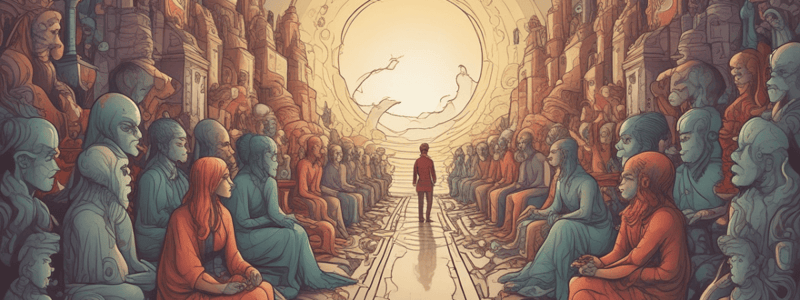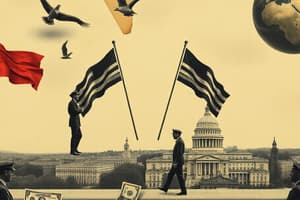Podcast
Questions and Answers
What is a social dilemma?
What is a social dilemma?
- A conflict where the most beneficial action for an individual harms everyone if chosen by most people (correct)
- A scenario where individuals prioritize group benefits over personal gains
- A situation where individual actions benefit everyone in the group
- A game theory concept that always leads to cooperative outcomes
In resolving social dilemmas, what is the 'Tit-for-tat' strategy?
In resolving social dilemmas, what is the 'Tit-for-tat' strategy?
- Always cooperate with others regardless of their actions
- Always defect to ensure personal benefit
- Randomly alternate between cooperation and defection
- Respond to cooperation with cooperation and to defection with defection (correct)
How can resource dilemmas be resolved according to the text?
How can resource dilemmas be resolved according to the text?
- Individuals should play the game as part of a group rather than individually
- Framing resource preservation as a common goal across people (correct)
- Keeping resource preservation strategies secret from others
- Competing to exhaust resources faster than others
What is the main idea behind 'Priming cooperative norms' in social dilemmas?
What is the main idea behind 'Priming cooperative norms' in social dilemmas?
Which strategy is recommended for resolving Prisoner's dilemma according to the text?
Which strategy is recommended for resolving Prisoner's dilemma according to the text?
What is the main focus of the prisoner's dilemma?
What is the main focus of the prisoner's dilemma?
Who were the original conceptualizers of the prisoner's dilemma?
Who were the original conceptualizers of the prisoner's dilemma?
Where was the prisoner's dilemma formalized and named?
Where was the prisoner's dilemma formalized and named?
Which field does not commonly apply the concepts of the prisoner's dilemma?
Which field does not commonly apply the concepts of the prisoner's dilemma?
What is the primary purpose of the prisoner's dilemma in strategic decision-making?
What is the primary purpose of the prisoner's dilemma in strategic decision-making?
How does the prisoner's dilemma contribute to diverse fields?
How does the prisoner's dilemma contribute to diverse fields?
What is the preferred course of action for consumers when shopping for a big-ticket item like a car?
What is the preferred course of action for consumers when shopping for a big-ticket item like a car?
How does the prisoner's dilemma impact consumer behavior during significant purchases?
How does the prisoner's dilemma impact consumer behavior during significant purchases?
What does Investopedia require writers to use as support for their work?
What does Investopedia require writers to use as support for their work?
How do car dealerships maximize their profits according to the text?
How do car dealerships maximize their profits according to the text?
What is the potential consequence for consumers if they don't engage in price negotiations when buying a car?
What is the potential consequence for consumers if they don't engage in price negotiations when buying a car?
How does understanding the relative payoffs of cooperating versus defecting benefit consumers?
How does understanding the relative payoffs of cooperating versus defecting benefit consumers?
What is the primary concern for both companies if one of them decides to drop its price?
What is the primary concern for both companies if one of them decides to drop its price?
In the context of the prisoner's dilemma, what does defecting refer to?
In the context of the prisoner's dilemma, what does defecting refer to?
How does defecting in the prisoner's dilemma impact electoral gains in the U.S. debt deadlock situation?
How does defecting in the prisoner's dilemma impact electoral gains in the U.S. debt deadlock situation?
Which scenario leads to both companies potentially earning lower profits due to increased advertising expenses?
Which scenario leads to both companies potentially earning lower profits due to increased advertising expenses?
What does 'cooperation' mean in the context of buying a car according to the text?
What does 'cooperation' mean in the context of buying a car according to the text?
How is defecting defined during salary negotiations according to the text?
How is defecting defined during salary negotiations according to the text?
'Prisoner's dilemma' can be applied in decision-making scenarios like:
'Prisoner's dilemma' can be applied in decision-making scenarios like:
'Cooperating' in the prisoner's dilemma of new technology development would involve:
'Cooperating' in the prisoner's dilemma of new technology development would involve:
What characterizes the essence of the prisoner's dilemma scenario?
What characterizes the essence of the prisoner's dilemma scenario?
In the prisoner's dilemma, what does 'defecting' refer to?
In the prisoner's dilemma, what does 'defecting' refer to?
Why is confessing the dominant strategy in the prisoner's dilemma?
Why is confessing the dominant strategy in the prisoner's dilemma?
What is the outcome when both suspects choose to defect in the prisoner's dilemma?
What is the outcome when both suspects choose to defect in the prisoner's dilemma?
Why might a rational individual in a prisoner's dilemma scenario choose to defect rather than cooperate?
Why might a rational individual in a prisoner's dilemma scenario choose to defect rather than cooperate?
What is the risk associated with not confessing in the prisoner's dilemma scenario?
What is the risk associated with not confessing in the prisoner's dilemma scenario?
What did Albert Tucker present the Prisoner's Dilemma as an example of?
What did Albert Tucker present the Prisoner's Dilemma as an example of?
How does cooperation affect the total prison sentence for A and B in the prisoner's dilemma?
How does cooperation affect the total prison sentence for A and B in the prisoner's dilemma?
Which scenario results in a one-year sentence for A and B in the prisoner's dilemma?
Which scenario results in a one-year sentence for A and B in the prisoner's dilemma?
What action leads to an unavoidable sentence of two years for A or B in the prisoner's dilemma?
What action leads to an unavoidable sentence of two years for A or B in the prisoner's dilemma?
What may lead to a lower degree of satisfaction for both the buyer and seller in a car purchase situation?
What may lead to a lower degree of satisfaction for both the buyer and seller in a car purchase situation?
In salary negotiations, what could result in leaving some money on the table?
In salary negotiations, what could result in leaving some money on the table?
In economic terms, what does it mean to 'defect'?
In economic terms, what does it mean to 'defect'?
What is an example of the prisoner's dilemma in economics according to the text?
What is an example of the prisoner's dilemma in economics according to the text?
What does the text highlight as a limitation of applying the prisoner's dilemma to real-world scenarios?
What does the text highlight as a limitation of applying the prisoner's dilemma to real-world scenarios?
What might lead to a lower level of satisfaction for both a job seeker and an employer during salary negotiations?
What might lead to a lower level of satisfaction for both a job seeker and an employer during salary negotiations?
What is necessary for the Nash Equilibrium to occur in the prisoner's dilemma?
What is necessary for the Nash Equilibrium to occur in the prisoner's dilemma?
What could be detrimental if one or more countries defect in adopting economic policies during a global economic crisis?
What could be detrimental if one or more countries defect in adopting economic policies during a global economic crisis?
What can result from ill-advised salary negotiations according to the text?
What can result from ill-advised salary negotiations according to the text?
What can result from leaving some money on the table in salary negotiations according to the text?
What can result from leaving some money on the table in salary negotiations according to the text?
Flashcards are hidden until you start studying
Study Notes
Social Dilemma and Prisoner's Dilemma
- A social dilemma is a conflict in which the most beneficial action for an individual will, if chosen by most people, have harmful effects for everyone.
- Examples of social dilemmas include the prisoner's dilemma and resource dilemmas.
Prisoner's Dilemma
- The prisoner's dilemma is a game theory scenario that illustrates the conflict between individual and collective rationality.
- It is often used to explain why cooperation is difficult to achieve in situations where individual interests conflict with collective interests.
The Prisoner's Dilemma Scenario
- Two suspects are arrested and interrogated separately by the police.
- Each suspect has two options: to confess or to remain silent.
- The payoff for each suspect depends on the actions of both suspects.
Payoff Matrix
- The payoff matrix shows the possible outcomes and payoffs for each suspect.
- The dominant strategy for each suspect is to confess, as it minimizes the average length of time spent in prison.
- However, if both suspects cooperate and remain silent, the total prison sentence is only two years.
Implications of Prisoner's Dilemma
- The prisoner's dilemma shows that when individual interests conflict with collective interests, cooperation may not be the best strategy.
- In reality, a rational person who is only interested in getting the maximum benefit for themselves would generally prefer to defect, rather than cooperate.
- The prisoner's dilemma has applications in various fields, including business, economics, and politics.
Applications in Business
- The prisoner's dilemma can be used to explain the behavior of firms in a competitive market.
- Examples include the competition between Coca-Cola and PepsiCo, and the rivalry between Apple and Samsung in the mobile phone market.
- In these situations, cooperation may lead to higher profits for both firms, but defecting may result in higher profits for one firm at the expense of the other.
Applications in Economics
- The prisoner's dilemma can be used to explain the behavior of governments in a global economy.
- Examples include the decision to implement expansionary fiscal policies during an economic downturn.
- If all countries cooperate and implement expansionary policies, the global economy can recover more effectively. However, if one country defects and pursues a more conservative fiscal approach, it may experience short-term economic stability, but the global impact could be detrimental.
Limitations of the Prisoner's Dilemma
- The prisoner's dilemma assumes a one-shot, non-repeated interaction, whereas many real-world scenarios involve repeated interactions.
- Cultural and contextual factors may influence decision-making, which is not accounted for in the prisoner's dilemma.
History of the Prisoner's Dilemma
- The prisoner's dilemma was conceptualized by Merrill Flood and Melvin Dresher at the Rand Corporation in 1950.
- It was later formalized and named by Canadian mathematician Albert William Tucker.
Importance of the Prisoner's Dilemma
- The prisoner's dilemma provides a framework for understanding how to strike a balance between cooperation and competition.
- It has applications in diverse areas, including business, finance, economics, and political science.
Studying That Suits You
Use AI to generate personalized quizzes and flashcards to suit your learning preferences.




